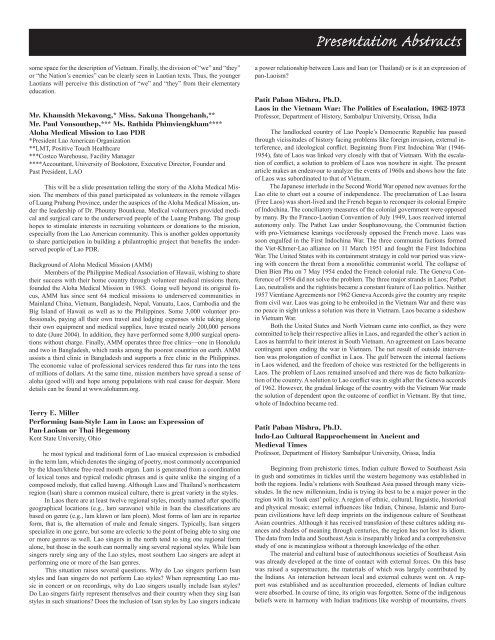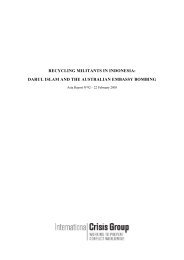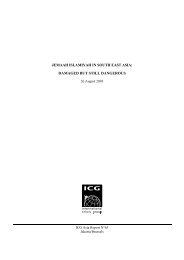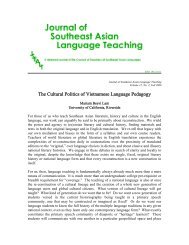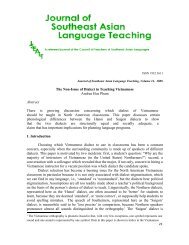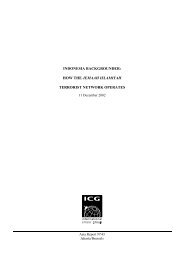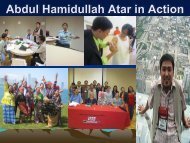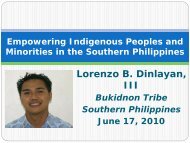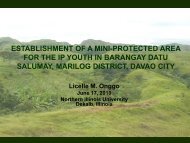Introduction - SEAsite - Northern Illinois University
Introduction - SEAsite - Northern Illinois University
Introduction - SEAsite - Northern Illinois University
Create successful ePaper yourself
Turn your PDF publications into a flip-book with our unique Google optimized e-Paper software.
Prentation Abstracts<br />
some space for the description of Vietnam. Finally, the division of “we” and “they”<br />
or “the Nation’s enemies” can be clearly seen in Laotian texts. Thus, the younger<br />
Laotians will perceive this distinction of “we” and “they” from their elementary<br />
education.<br />
Mr. Khamsith Mekavong,* Miss. Sakuna Thongchanh,**<br />
Mr. Paul Vonsouthep,*** Ms. Rathida Phimviengkham****<br />
Aloha Medical Mission to Lao PDR<br />
*President Lao American Organization<br />
**LMT, Positive Touch Healthcare<br />
***Costco Warehouse, Facility Manager<br />
****Accountant, <strong>University</strong> of Bookstore, Executive Director, Founder and<br />
Past President, LAO<br />
This will be a slide presentation telling the story of the Aloha Medical Mission.<br />
The members of this panel participated as volunteers in the remote villages<br />
of Luang Prabang Province, under the auspices of the Aloha Medical Mission, under<br />
the leadership of Dr. Phoumy Bounkeua. Medical volunteers provided medical<br />
and surgical care to the underserved people of the Luang Prabang. The group<br />
hopes to stimulate interests in recruiting volunteers or donations to the mission,<br />
especially from the Lao American community. This is another golden opportunity<br />
to share participation in building a philantrophic project that benefits the underserved<br />
people of Lao PDR.<br />
Background of Aloha Medical Mission (AMM)<br />
Members of the Philippine Medical Association of Hawaii, wishing to share<br />
their success with their home country through volunteer medical missions there,<br />
founded the Aloha Medical Mission in 1983. Going well beyond its original focus,<br />
AMM has since sent 64 medical missions to underserved communities in<br />
Mainland China, Vietnam, Bangladesh, Nepal, Vanuatu, Laos, Cambodia and the<br />
Big Island of Hawaii as well as to the Philippines. Some 3,000 volunteer professionals,<br />
paying all their own travel and lodging expenses while taking along<br />
their own equipment and medical supplies, have treated nearly 200,000 persons<br />
to date (June 2004). In addition, they have performed some 8,000 surgical operations<br />
without charge. Finally, AMM operates three free clinics—one in Honolulu<br />
and two in Bangladesh, which ranks among the poorest countries on earth. AMM<br />
assists a third clinic in Bangladesh and supports a free clinic in the Philippines.<br />
The economic value of professional services rendered thus far runs into the tens<br />
of millions of dollars. At the same time, mission members have spread a sense of<br />
aloha (good will) and hope among populations with real cause for despair. More<br />
details can be found at www.alohamm.org.<br />
Terry E. Miller<br />
Performing Isan-Style Lam in Laos: an Expression of<br />
Pan-Laoism or Thai Hegemony<br />
Kent State <strong>University</strong>, Ohio<br />
he most typical and traditional form of Lao musical expression is embodied<br />
in the term lam, which denotes the singing of poetry, most commonly accompanied<br />
by the khaen/khene free-reed mouth organ. Lam is generated from a coordination<br />
of lexical tones and typical melodic phrases and is quite unlike the singing of a<br />
composed melody, that called hawng. Although Laos and Thailand’s northeastern<br />
region (Isan) share a common musical culture, there is great variety in the styles.<br />
In Laos there are at least twelve regional styles, mostly named after specific<br />
geographical locations (e.g., lam saravane) while in Isan the classifications are<br />
based on genre (e.g., lam klawn or lam ploen). Most forms of lam are in repartee<br />
form, that is, the alternation of male and female singers. Typically, Isan singers<br />
specialize in one genre, but some are eclectic to the point of being able to sing one<br />
or more genres as well. Lao singers in the north tend to sing one regional form<br />
alone, but those in the south can normally sing several regional styles. While Isan<br />
singers rarely sing any of the Lao styles, most southern Lao singers are adept at<br />
performing one or more of the Isan genres.<br />
This situation raises several questions. Why do Lao singers perform Isan<br />
styles and Isan singers do not perform Lao styles? When representing Lao music<br />
in concert or on recordings, why do Lao singers usually include Isan styles?<br />
Do Lao singers fairly represent themselves and their country when they sing Isan<br />
styles in such situations? Does the inclusion of Isan styles by Lao singers indicate<br />
a power relationship between Laos and Isan (or Thailand) or is it an expression of<br />
pan-Laoism?<br />
Patit Paban Mishra, Ph.D.<br />
Laos in the Vietnam War: The Politics of Escalation, 1962-1973<br />
Professor, Department of History, Sambalpur <strong>University</strong>, Orissa, India<br />
The landlocked country of Lao People’s Democratic Republic has passed<br />
through vicissitudes of history facing problems like foreign invasion, external interference,<br />
and ideological conflict. Beginning from First Indochina War (1946-<br />
1954), fate of Laos was linked very closely with that of Vietnam. With the escalation<br />
of conflict, a solution to problem of Laos was nowhere in sight. The present<br />
article makes an endeavour to analyze the events of 1960s and shows how the fate<br />
of Laos was subordinated to that of Vietnam.<br />
The Japanese interlude in the Second World War opened new avenues for the<br />
Lao elite to chart out a course of independence. The proclamation of Lao Issara<br />
(Free Laos) was short-lived and the French began to reconquer its colonial Empire<br />
of Indochina. The conciliatory measures of the colonial government were opposed<br />
by many. By the Franco-Laotian Convention of July 1949, Laos received internal<br />
autonomy only. The Pathet Lao under Souphanovoung, the Communist faction<br />
with pro-Vietnamese leanings vociferously opposed the French move. Laos was<br />
soon engulfed in the First Indochina War. The three communist factions formed<br />
the Viet-Khmer-Lao alliance on 11 March 1951 and fought the First Indochina<br />
War. The United States with its containment strategy in cold war period was viewing<br />
with concern the threat from a monolithic communist world. The collapse of<br />
Dien Bien Phu on 7 May 1954 ended the French colonial rule. The Geneva Conference<br />
of 1954 did not solve the problem. The three major strands in Laos; Pathet<br />
Lao, neutralists and the rightists became a constant feature of Lao politics. Neither<br />
1957 Vientiane Agreements nor 1962 Geneva Accords give the country any respite<br />
from civil war. Laos was going to be embroiled in the Vietnam War and there was<br />
no peace in sight unless a solution was there in Vietnam. Laos became a sideshow<br />
in Vietnam War.<br />
Both the United States and North Vietnam came into conflict, as they were<br />
committed to help their respective allies in Laos, and regarded the other’s action in<br />
Laos as harmful to their interest in South Vietnam. An agreement on Laos became<br />
contingent upon ending the war in Vietnam. The net result of outside intervention<br />
was prolongation of conflict in Laos. The gulf between the internal factions<br />
in Laos widened, and the freedom of choice was restricted for the belligerents in<br />
Laos. The problem of Laos remained unsolved and there was de facto balkanization<br />
of the country. A solution to Lao conflict was in sight after the Geneva accords<br />
of 1962. However, the gradual linkage of the country with the Vietnam War made<br />
the solution of dependent upon the outcome of conflict in Vietnam. By that time,<br />
whole of Indochina became red.<br />
Patit Paban Mishra, Ph.D.<br />
Indo-Lao Cultural Rapprochement in Ancient and<br />
Medieval Times<br />
Professor, Department of History Sambalpur <strong>University</strong>, Orissa, India<br />
Beginning from prehistoric times, Indian culture flowed to Southeast Asia<br />
in gush and sometimes in tickles until the western hegemony was established in<br />
both the regions. India’s relations with Southeast Asia passed through many vicissitudes.<br />
In the new millennium, India is trying its best to be a major power in the<br />
region with its ‘look east’ policy. A region of ethnic, cultural, linguistic, historical<br />
and physical mosaic; external influences like Indian, Chinese, Islamic and European<br />
civilizations have left deep imprints on the indigenous culture of Southeast<br />
Asian countries. Although it has received transfusion of these cultures adding nuances<br />
and shades of meaning through centuries, the region has not lost its idiom.<br />
The data from India and Southeast Asia is inseparably linked and a comprehensive<br />
study of one is meaningless without a thorough knowledge of the other.<br />
The material and cultural base of autochthonous societies of Southeast Asia<br />
was already developed at the time of contact with external forces. On this base<br />
was raised a superstructure, the materials of which was largely contributed by<br />
the Indians. An interaction between local and external cultures went on. A rapport<br />
was established and as acculturation proceeded, elements of Indian culture<br />
were absorbed. In course of time, its origin was forgotten. Some of the indigenous<br />
beliefs were in harmony with Indian traditions like worship of mountains, rivers


